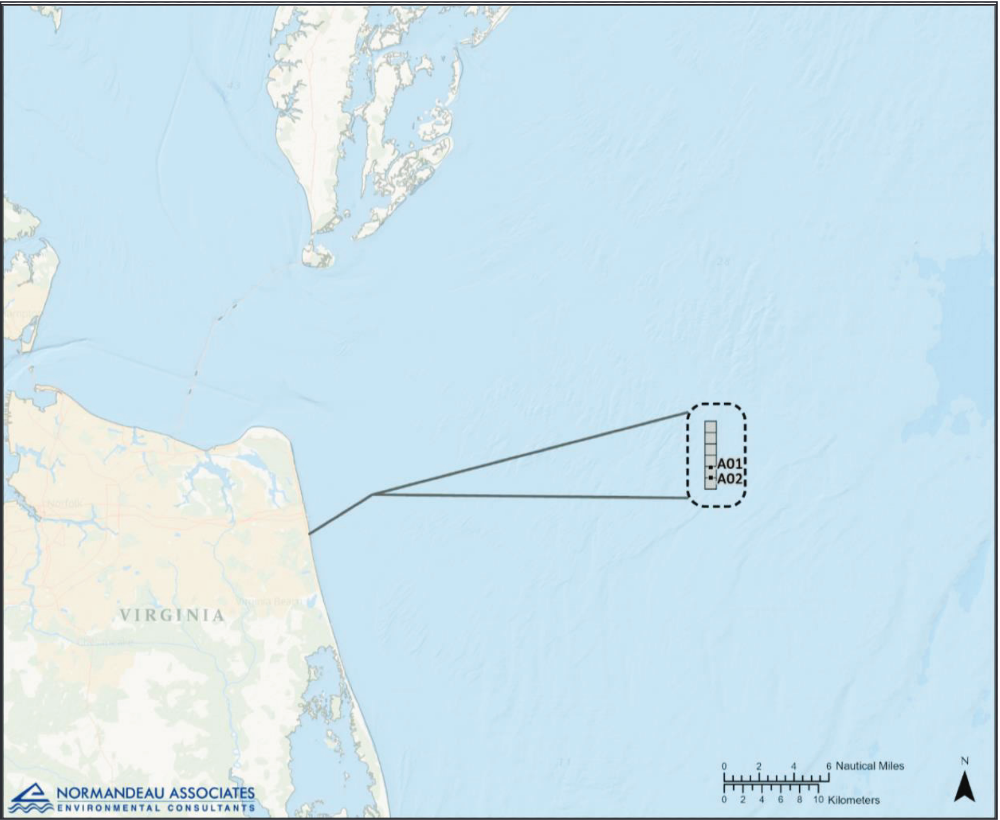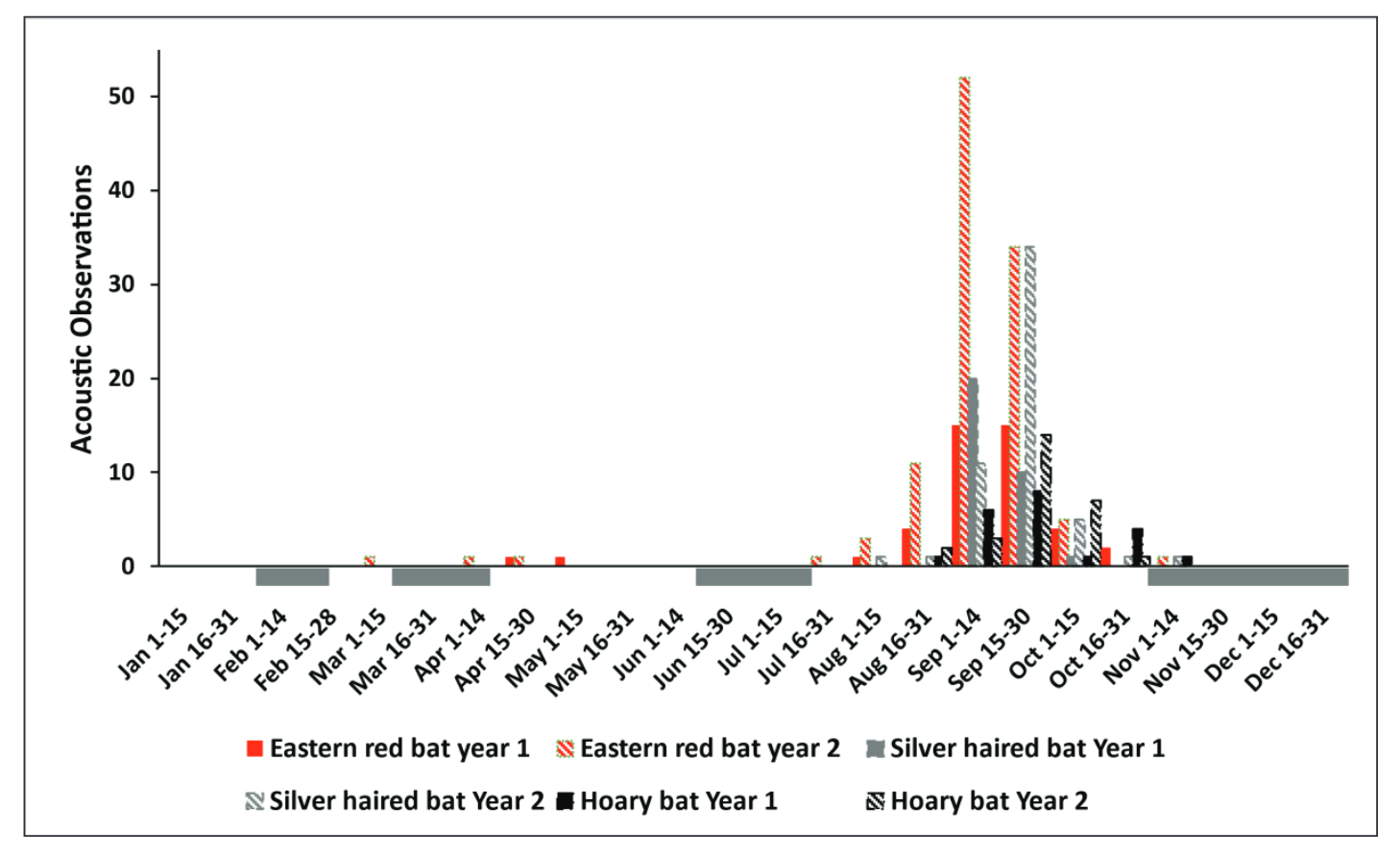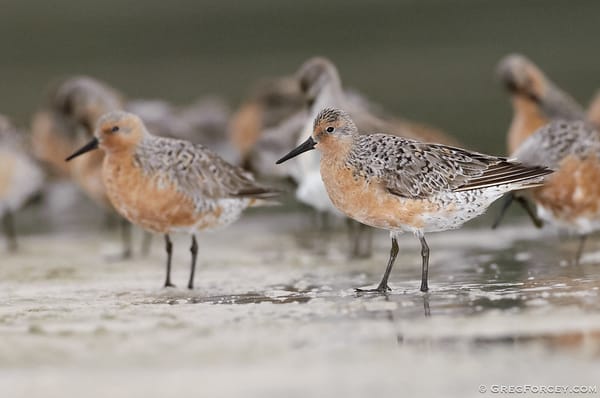How does bat activity change at wind turbines across years in the offshore Atlantic Ocean?
Variation in bat activity from year to year and within years could influence collision risk from offshore wind turbines.

Records of bats offshore are limited, given the difficulty in detecting bats and accessing offshore waters for scientific research. Remote sensing technology, including cameras, acoustics, and VHF receivers, is providing new methods for collecting data on offshore wildlife. In a recent study conducted at an offshore wind turbine in Virginia, we observed strong patterns of bat activity during the fall, with over 30% of the observations occurring during the day. Foraging and avoidance behaviors were common, and no collisions were observed during the study.
Background
The offshore environment presents challenging logistical and environmental conditions for traditional field-based surveys, which limit data collection. However, remote sensing technologies such as radar, cameras, acoustics, and radio receivers provide a means to collect data year-round in extreme environmental conditions.
While traditionally thought of as occurring over land, bats’ use of the offshore environment is becoming increasingly studied, thanks to developments in remote sensing technology. While bat occurrence offshore has been extensively documented in Europe, and to a lesser extent in the United States, there is limited information on bat behavior and how bats interact with offshore structures. Limited bat data offshore are due to inaccessibility, bats' nocturnal habits, and small size. Acoustic surveys, one of the most common methods for surveying bats on land, are challenging offshore because pelagic boat surveys are expensive, and high levels of ambient noise make acoustic analysis particularly challenging.
Bat behavior offshore has recently been of interest, with the potential for wind expansion into the Atlantic in the coming years, which poses risks of collision and displacement.
How were bats studied offshore?
To learn more about bat activity and behavior offshore, researchers Amichai, myself, and colleagues used a remote sensing array called ATOM (Acoustic and Thermographic Offshore Monitoring) to collect bat occurrence and behavior data offshore at the Coastal Virginia Offshore Wind Pilot Project in Virginia (Figure 1). ATOM is a collection of thermal cameras, visible light cameras, bird and bat acoustics, and a Motus receiver. Our study recorded the species identification, timing, and behavior of each bat observed and used the visible-light cameras to provide species identification when possible.

What offshore bat findings were observed?
Our study identified three bat species offshore: eastern red bat, hoary bat, and silver-haired bat. These species were observed throughout the year, with 89% of observations occurring between mid-August and mid-October. High activity during this period occurred in both year 1 and year 2, with 91% of bat observation occurring in the fall during year 1 and 88% of bat observations occurring during the fall in year 2 (Figure 2). We speculate that most of the activity is associated with fall migration, rather than mating, which also typically occurs during the fall. We did not observe any mating when examining the video footage.

As expected, our study found that most bat activity occurred during the night; however, a surprisingly large number of bats were observed during daylight hours. In year 1, 38% of acoustic and visual observations occurred during the day; similarly, in year 2, 31% of bat observations occurred during the day.
Of the bat behaviors we observed in the video, 83% were related to foraging, either catching insects on the wing or gleaning insects from the turbine monopole. The other major behavior included 13% of bat observations interacting with turbine blades, either adjusting flight speed or flight direction (Figure 3).

Our study also showed that 64% of the visual bat observations occurred when the blades were spinning, which implies that collision risk may be lower than expected, given that blades are not always spinning when bats are active at the turbines. While we did not observe any collisions, we did observe three “air displacements” where bats quickly changed their behavior when near the spinning blades.
Conclusions
What was previously considered rare, bat activity offshore may be more common than previously thought. Our study found three bat species, located 27 miles from the Virginia coast, engaging in migratory and foraging behaviors, primarily during the fall. The bat species we observed are all migratory tree-roosting bats, which are strong flyers that forage in open spaces and frequently travel long distances daily and seasonally. These characteristics make them more likely to occur offshore compared to other bat species.
In addition to migration, breeding activity commonly occurs for bats in the fall, but our study did not document any breeding behavior. Our study assumed foraging behavior based on observing bats and insects in the video, but they were not observed simultaneously. Insects were common at the turbines during the fall, but it isn’t known if bats were attracted to the turbines themselves or because of the abundant insects.
Our study is one of the first to demonstrate a significant proportion (>30%) of bat activity occurring offshore during the day, which was observed in both years of the study. While significant daytime activity is unusual over land, daytime activity offshore is not as surprising, given the lack of natural roosts and fewer aerial predators. In addition, 36% of the visual bat observations were seen with the blades not spinning. Both of these findings have implications for collision risk. Bats may be at a higher daytime risk for collisions than previously thought, given the amount of activity observed during this time, but have a lower overall collision risk, considering the large number of observations when the blades were not spinning.
Bats are commonly struck by spinning blades at terrestrial wind farms. While our study observed no collisions, we do not know if this was due to limited camera coverage, lower bat activity compared to land, or because bat collisions offshore occur less frequently than onshore. More study on offshore bat collisions is warranted, given these unknowns.
Using a multi-sensor system offered several benefits over a single-sensor setup. Thermal imagery provided detections in all weather conditions, both day and night, even when not detected by acoustics. Visible-light imagery enabled many detections to be identified to the species level, particularly during the day. Both video sensors allowed us to identify bat behavior that would not have been possible with acoustics alone. Acoustic sensors supplemented data collection from the cameras by providing species identifications at night and when bats were not flying in the cameras’ viewshed.
References
Amichai, E., G. M. Forcey, M. Vukovich, and J. R. Willmott. 2025. Multi-sensor arrays provide complementary information on bat presence and activity in the offshore environment. Journal of North American Bat Research 3:75–88. https://eaglehill.us/NABRonline/access-pages/spec01/006-Amichai-accesspage.shtml
Robinson Willmott, J., G. Forcey, and M. Vukovich. 2023. New insights into the influence of turbines on the behaviour of migrant birds: implications for predicting impacts of offshore wind developments on wildlife. Journal of Physics: Conference Series 2507:012006. https://dx.doi.org/10.1088/1742-6596/2507/1/012006





